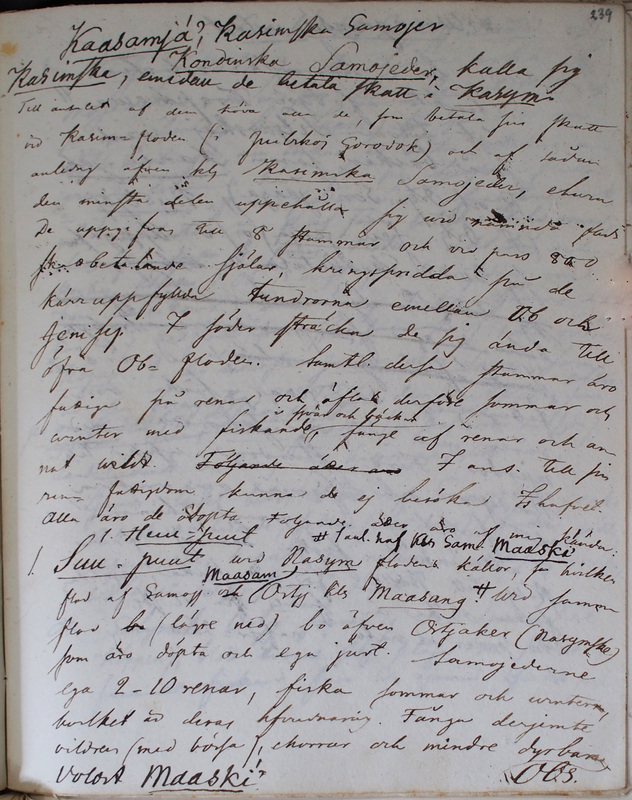Ethnographiska, historiska och statistiska anmärkningar. 239
Title
Ethnographiska, historiska och statistiska anmärkningar. 239
Description
|
Kondinska Samojeder
Kasimska Samojeder, kalla sigRu kondinskie samoedy is one of the territorial denominations used for the Forest Nenets. It refers to the River Konda and the town of Konda (Kartauž), which was the centre for the Konda princedom known as the Mansi princedom, initially part of the Pelym princedom (Bachrušin 1935: 30–32; 74–84). Later, the area became part of the Kazym volostʹ and the Nenets begun to pay their yasak in the town of Kazym.
Kasimska Kaasamjá, emedan de betala skatt i Kasym. Till antalet af dem höra alla de, som betala sin skatt vid Kasim=floden (i Juilskoi Gorodok)
och af sådanThe town of Juilʹsk, already known in the 17th century, is one of the centres of the Ljapin princedom. Situated on the River Sygva (Bachrušin 1935: 67).
anledng[anledning] äfven kls[kallas] Kasimska Samojeder, ehuru den minsta delen uppehålla sig wid närvde[närvarande] flodr.[floder] De uppgifvas till 8 stammar
och vid pass 800The list of families gives only six names.
skattbetalande själar, kringspridda på de kärruppfyllda tundrorna emellan Ob och Jenisej. I söder sträcka de sig ända till öfra Ob=floden. Samtl[iga]. dessa stammar äro fattiga på renar och äfla derföre sommar och winter med fiskande i sjöar och bäck , fänge af renar och an nat wildt. |
The Kondin Samoyeds (Kasim Samoyeds) call themselves Kasim or Kaasamjá, because they pay taxes in Kasym. Those who pay their taxes at the River Kasim (in the town of Juilskoi) are counted as belonging to them and this is the reason they are also called the Kasim Samoyeds, though only a minority reside by the nearby rivers. They are divided into eight tribes consisting of around 800 tax-paying souls, scattered on the boggy tundra between the Ob and the Yenisei. In the south, they extend all the way to the upper Ob. Each of these tribes is poor in reindeer and therefore they practise fishing in the lakes and rivers during the summer and winter, hunting wild reindeer and other game. Given their small number of reindeer, they cannot visit the Arctic Ocean. They are all unbaptised. |
| Följande ätter äro I ans[eende]. till sin rens fattigdom kunna de ej besöka Ishavet. Alla äro de odöpta. Följande ätter äro af mig kända: 1. Suu=puut
Huu=puut wid
This name is first mentioned by Castrén and is not mentioned later in the ethnographic literature.
Nasym
flodens källor, hvilken floden af Samojj.[Samojeder] [kallas] Maasam och Ostjj. kls[kallas] Maasang I anl. haf kls[kallas] Sam.[Samojeder] Maaski' Wid sammaThe Nazym flows into the Obˈ from the right (north-east) at N61°11′48″ E68°55′41″. (TS)
flod (lägre ned) bo äfven Ostjaker (Nasymska) som äro döpta och ega jurt. Samojederne ega 2-10 renar, fiska sommar och wintern, hvilket är deras hfvudnäring. Fånga derjemte vildren (med bössa), ekorrar och mindre dyrbara. Volost Maaskí. Obs. |
The following families are known to me: 1. The Suu-puut (Huu-puut) at the sources of the River Nasym, which the Samoyeds call the Maasam and the Ostyaks the Maasang; the Samoyeds living by the sea call it the Maaski'. On the same river (lower down) there are also Ostyaks (Nasym) who are baptised and have yurts. The Samoyeds have two to ten reindeer; they fish during the summer and winter, and this is their main source of livelihood. They also hunt wild reindeer (with rifles), squirrels, and less valuable animals.
Volost Maaskí. NB: |

